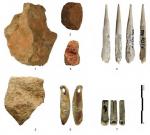Summary (English)
REDAKA 2 CAVE (Aleta Guadelli – aleta.guadelli@gmail.com, Jean-Luc Guadelli, Nikolai Sirakov) The explorations of the Upper Paleolithic strata continued and the same lithostratigraphic units were documented, as during the previous excavations. Hearth No. 2 was thoroughly explored and Hearth No. 3 was discovered at 1.45 – 1.50 m in depth. Several bone artifacts discovered during the previous explorations were related to Hearth No. 3 and pieces of ochre were found during the present excavations. The three hearths explored in 2012 and 2013 were situated in one and the same geological layer. The finds from the excavations comprised flint artifacts (points, flakes and punches) related to the Gravettian tool-making culture. The discovered animal bones were from ox (Bovinae), goats (Caprinae), horses (Equus caballus cf. germanicus), Hispanic wild goats (Rupicapra rupicapra), northern deer (Rangifer tarandus), foxes (Vulpes vulpes), hyenas (Crocuta crocuta spelaea), wolves (Canis lupus) and cave lions (Panthera spelaea), and 19,64 % from the bones had traces from hyenas, while 4,46 % had traces from human activities. Two teeth and a fragment from a skull, probably belonging to humans (Homo sapiens?) were discovered in the context of Hearth No. 2. However, due to the hyenas’ digestion, it is impossible to attribute the anthropological material to any particular human specie. During the Upper Paleolithic period, the cave was relatively regularly visited by groups of hunters and hyenas from 39/36 to 25 Ka BP.
- Aleta Guadelli - Archaeological Institute with Museum
- Jean-Luc Guadelli - PACEA/IPGQ–UMR CNRS 5199, Université Bordeaux I
- Nikolai Sirakov - Archaeological Institute with Museum
Director
Team
Research Body
- Archaeological Institute with Museum
- Université Bordeaux I






![Download [PDF]](/excavation/skins/fasti/images/results/download_sml.png)

